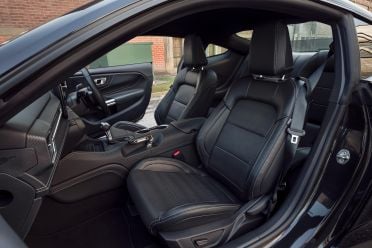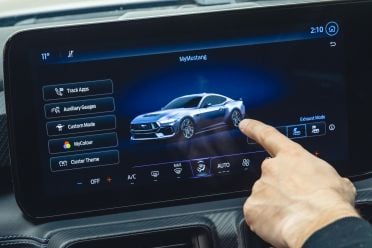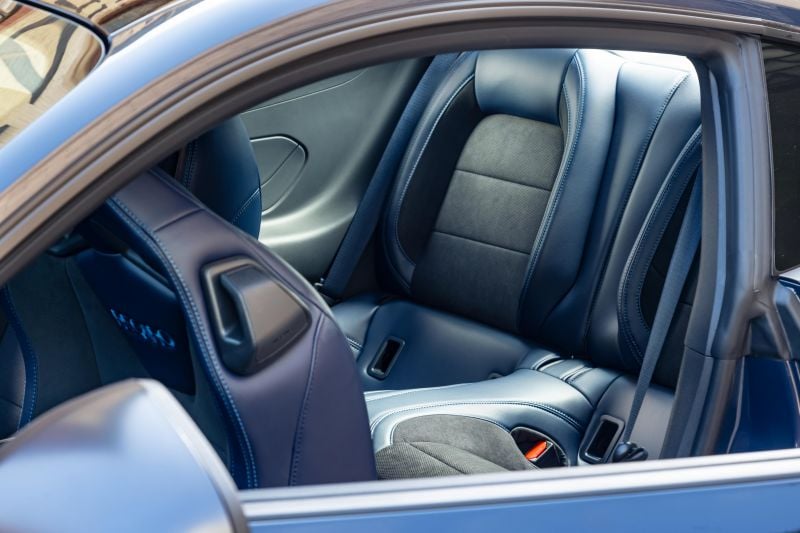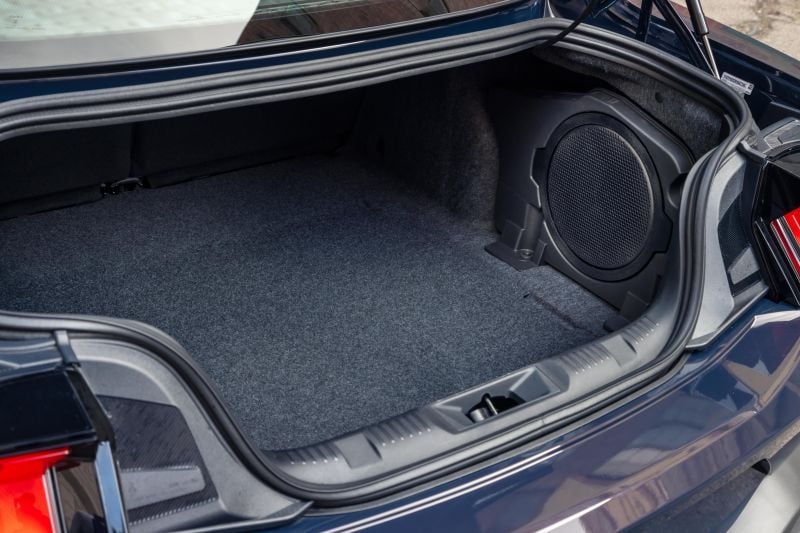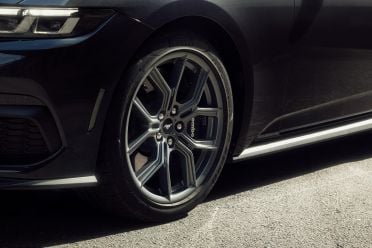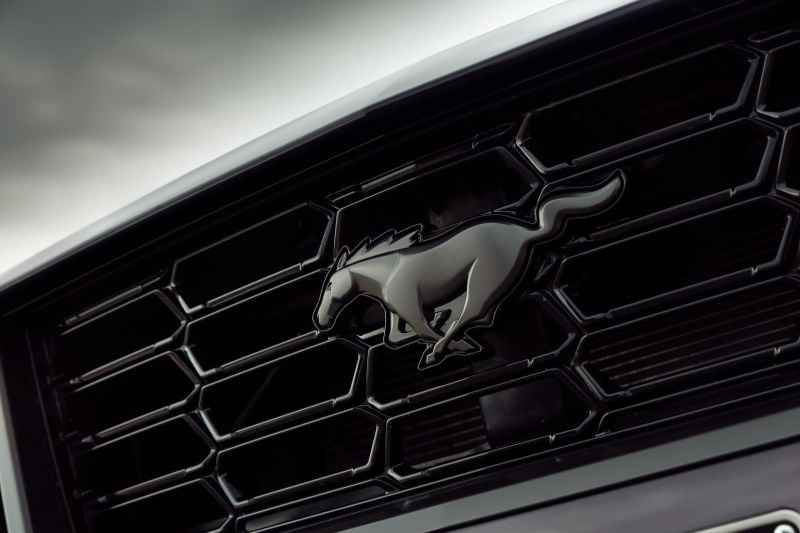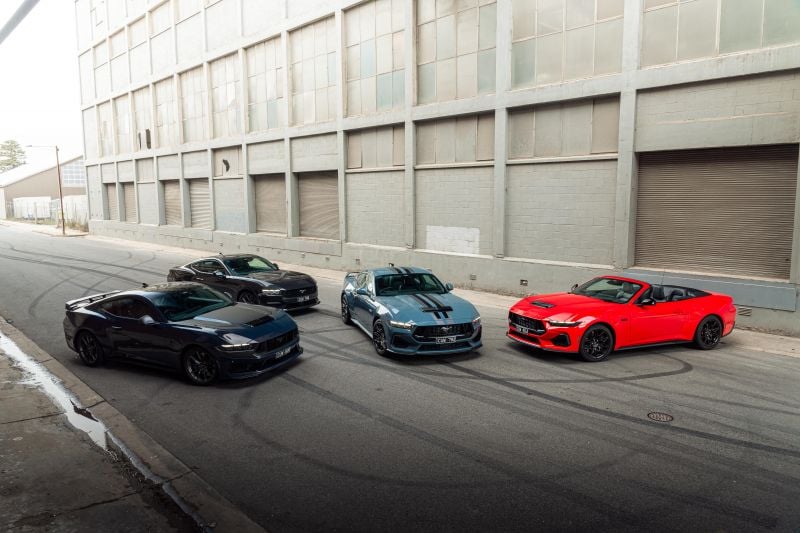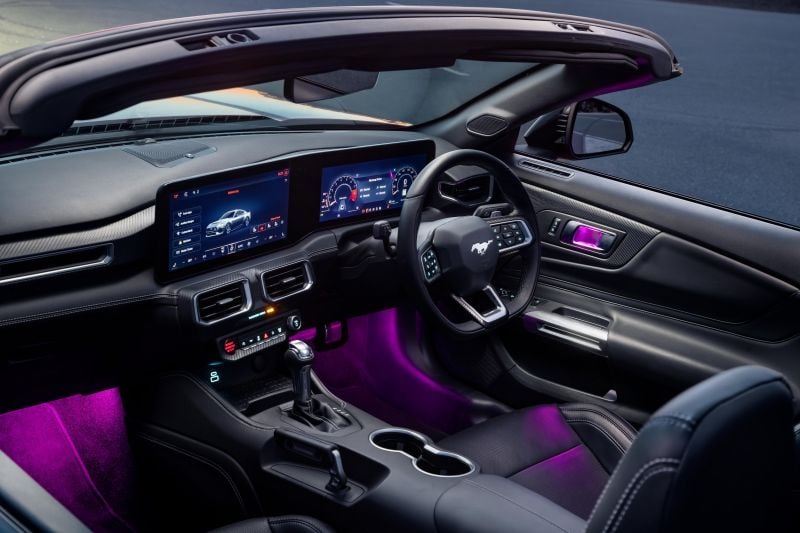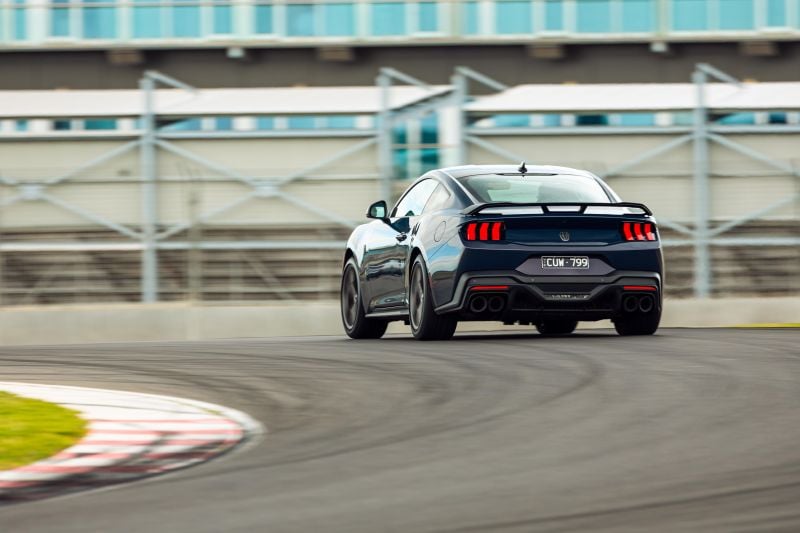The word icon is thrown around lightly at times, but the Ford Mustang has earned it. It’s still the definitive muscle car.
-
GT Convertible
Even icons need to evolve. Although it still packs a snarling V8 engine under the bonnet, the option of a manual, and rear-wheel drive across the range, the seventh-generation Mustang you see here is a meaningfully more modern take on the formula than those before it.
Forget hooded dials and retro trim; the cabin has been given a high-tech overhaul that’s more Munich than Midwest, and the exterior is a sharper, more aggressive take on the formula we’ve known and loved since the 1960s.
This new Mustang has been a long time coming for Australia. Initially slated to arrive before the end of 2023, the first owners are only now getting their hands on the car – and anyone making a fresh order will need to order an MY25, with higher prices and a revised list of options and colours.
-
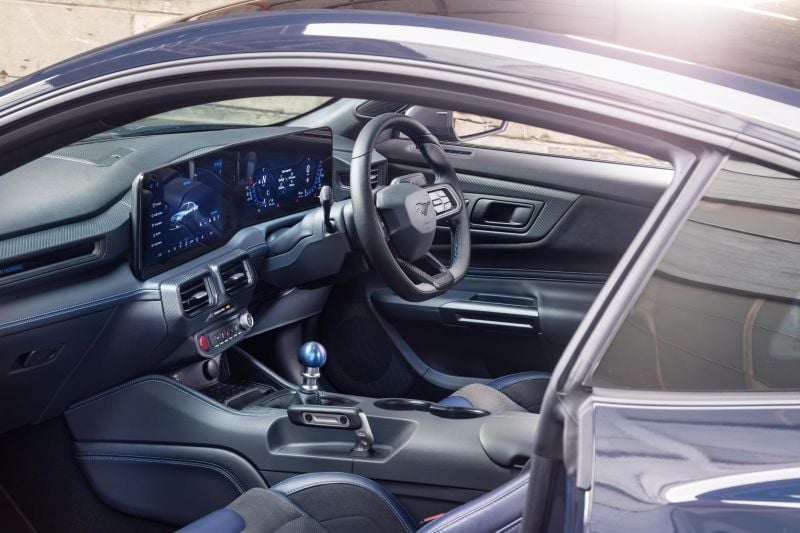
Dark Horse
Anyone who wants a Dark Horse is also out of luck – just 1000 were offered, and they’re all sold out.
Ford still let us loose in the Dark Horse on track though, as part of a comprehensive range-wide launch drive to see if the Mustang still has what it takes in 2024.
How does the Ford Mustang compare?
View a detailed breakdown of the Ford Mustang against similarly sized vehicles.

Ford
Mustang
How much does the Ford Mustang cost?
Prices are up across the Mustang range for 2025, to the tune of up to $2000.
-
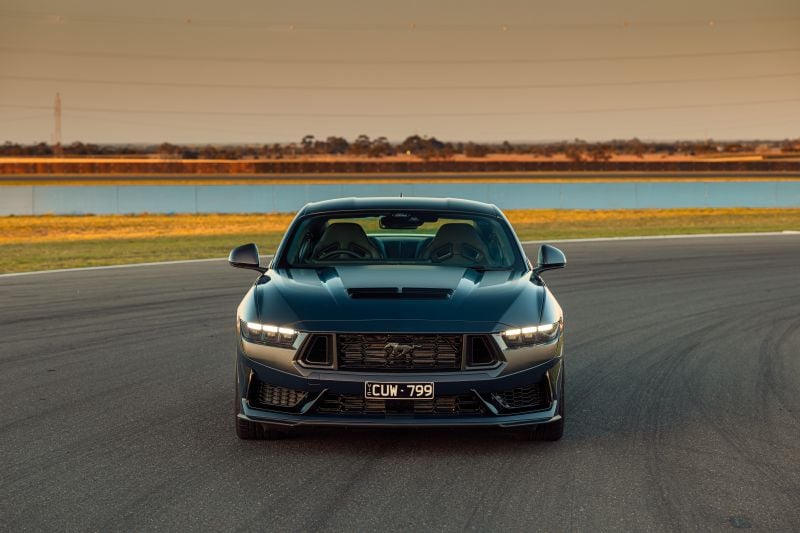
Dark Horse
You’ll notice the Dark Horse isn’t included in this list. That’s because it was offered in limited numbers for the 2024 model year, and hasn’t made the jump to 2025.
Just 1000 were available, and all have been snapped up. Ford hasn’t closed the book on a return Down Under, however.
| Model | Price before on-road costs |
|---|---|
| 2025 Ford Mustang EcoBoost Fastback auto | $66,990 |
| 2025 Ford Mustang GT Fastback manual | $78,990 |
| 2025 Ford Mustang GT Fastback auto | $81,990 |
| 2025 Ford Mustang GT Convertible auto | $87,667 |
To see how the Mustang lines up against the competition, check out our comparison tool.
What is the Ford Mustang like on the inside?
This is where the biggest changes have been wrought on the new Ford Mustang.
-

EcoBoost Fastback
Gone is the retro-inspired dashboard, replaced by a glossy dual-screen display that looks as if it’s been lifted from a German coupe. If you’re a traditionalist, it’ll make you feel very nervous. If you’re young, it’ll make you feel at home.
The fundamentals remain excellent, thanks in no small part to the car’s size. Rather than folding yourself in like a Nissan Z or Toyota Supra, you can drop into the Mustang and really stretch out as a tall driver.
It’s a comfortable place to spend time, regardless of whether you have the standard seats or optional Recaro buckets fitted.
The ergonomics are good. The flat-bottom steering wheel is smaller than before and feels great in your hands, and the gear knob on the manual sits nicely in your hand – although the titanium unit on the Dark Horse is better.
In both, the shifter is slightly too far towards the rear of the vehicle for my liking on track, but it’s only by a small margin. The brake and accelerator are also just slightly too far apart for comfortable, reliable rev matching.
You still get cupholders on the transmission tunnel, and bottles in there still get in the way if you’re trying to shift the manual. The Drift Brake is also over the wrong side of the cabin, forcing you to reach across the transmission tunnel to rip skids… or put the parking brake on. It’s a carryover issue, as the last model suffered the same fate.
The inclusion of USB-A and USB-C ports is a win, as is the wireless charger… that’s being booted for 2025 in line with a global production change.
The infotainment system is a huge step forward from before. The central screen is running a version of Ford’s latest Sync software, and feels properly modern. The graphics are flashy, it responds quickly to inputs, and it has plenty of performance pages to play with.
Wireless Apple CarPlay and Android Auto feature. Gone are the physical climate control dials, replaced with touch buttons at the base of the display.
They’re not as easy to use as old-fashioned buttons, but you don’t need too many swipes or prods to adjust the fan speed, for example.
Also gone are the plastic-chrome toggles at the base of the dashboard from the old car, replaced with a pod of shortcuts that feel a little bit cheap. They’re an improvement, but they’re still not quite up to scratch.
The digital dashboard is excellent, with layouts based on your drive mode. The 1960s knock-off gauge option is a lovely touch, as are the Fox Body and late-1990s SVT options, but it’s a shame you can’t couple them with a digital speedometer.
Rear seat space is the same as before… which is to say it’s tight.
You’ll need to be flexible or very small to get back there, and once you’re back there the sloping roofline and short seat base make it a pretty uncomfortable place to spend time.
There are no air vents, no USB ports, and no cupholders.
Then again, you’re not buying a Mustang as a family car – and boot space is excellent, with room for two sets of golf clubs.
| Dimensions | Ford Mustang |
|---|---|
| Length | 4811mm |
| Width | 2097mm |
| Height | 1407-1414mm |
| Wheelbase | 2719mm |
To see how the Mustang lines up against the competition, check out our comparison tool.
What’s under the bonnet?
The engines offered in the Ford Mustang for 2024 and 2025 are evolutions of those in the sixth-generation car.
-
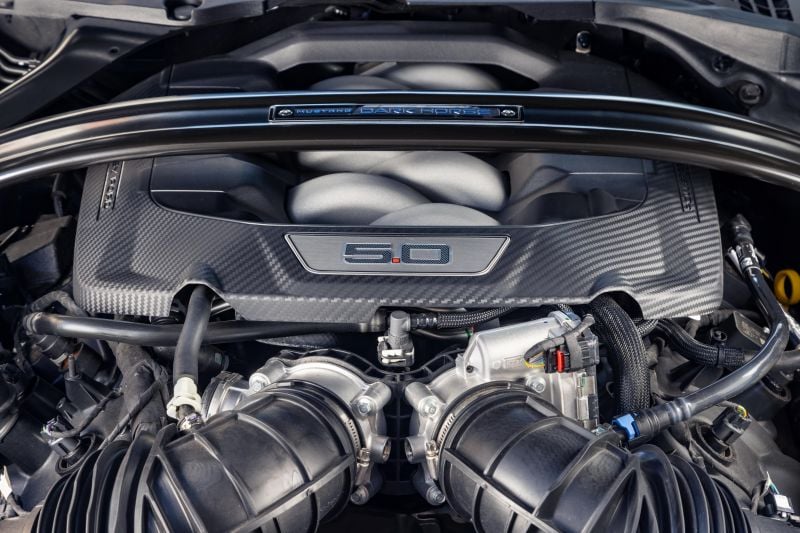
Dark Horse
The 2.3-litre EcoBoost engine remains the entry point, and is only offered with a 10-speed automatic transmission. It’s a slow seller in Australia, with most buyers opting for the big, burbling V8 instead.
Our Dark Horse is down on power compared to the American model due to changes made for right-hand drive. Although it’s only up 5kW on the GT, the six-speed manual packs a shorter final drive ratio to deliver more in-gear punch.
| Specifications | EcoBoost | GT | Dark Horse |
|---|---|---|---|
| Engine | 2.3L 4cyl turbo | 5.0L V8 | 5.0L V8 |
| Power | 232kW @ 5500rpm | 345kW @ 7250rpm | 350kW @ 7250rpm |
| Torque | 475Nm @ 3000rpm | 550Nm @ 4850rpm | 550Nm @ 4850rpm |
| Transmission | 10-speed auto | 10-speed auto/6-speed manual | 10-speed auto/6-speed manual |
| Driven wheels | RWD | RWD | RWD |
| Weight | 1746kg | 1813-1881kg | 1822-1842kg |
| Fuel economy (claimed) | 9.4L/100km | 12.8-13.6L/100km | 12.8-15.4L/100km |
| Fuel economy (as tested) | N/A | N/A | N/A |
| Fuel tank capacity | 61L | 61L | 61L |
| Fuel requirement | 98 RON | 98 RON | 98 RON |
| CO2 emissions | 215g/km | 293-310g/km | 293-353g/km |
To see how the Mustang lines up against the competition, check out our comparison tool.
How does the Ford Mustang drive?
You really want to know about the V8, right? Bad luck, because we’re going to start with the EcoBoost.
-
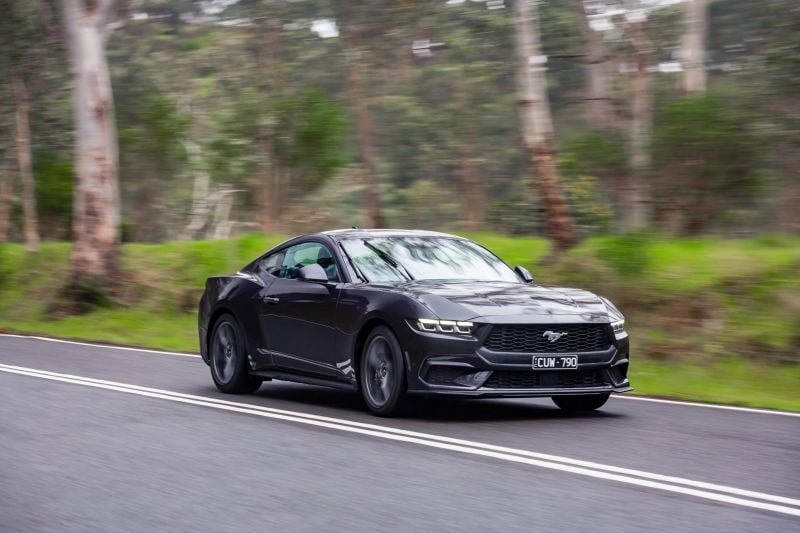
EcoBoost Fastback
It only accounts for a small percentage of sales in Australia, but it’s been treated to some big changes. Ford says it’s been completely overhauled, despite sharing its displacement and similar outputs with the engine it replaces.
Prod the start button and it fires with a flat bark that’s not quite as harsh as a Focus RS, but is still purposeful.
It’s quick in a straight line, squeezing you back in the seat and determinedly pulling to the redline, and mid-range punch in particular is impressive. There’s a decent bark from the exhaust, and shifts are sharp when you grab the paddles behind the wheel.
With 10 closely stacked gears to play with it’s rarely caught off the boil when you’re in a hurry, although it can take a beat to kick down one, two, or three gears from a cruise.
Our time in the EcoBoost was spent on the highway, but previous experience shows cutting four cylinders, 2.7 litres, and around 120kg from the Mustang’s front end makes it a sweeter car to drive on a twisty road. It just doesn’t make you feel like the V8.
From the second it fires into life, the 5.0-litre V8 in the GT and Dark Horse dominates the Mustang experience. It’s such a characterful engine, and is so capable in so many different environments.
In a world dominated by turbocharged, small-displacement engines bursting with low-end torque but strangled for character, the way its builds from loping around low in the rev range, roaring through its mid-range, and snarling to the 7400rpm redline is immensely satisfying.
It sounds angry in Normal mode, with a brassy snarl that feels a step closer to the demonic wail of the flat-plane crank V8 in the Shelby GT350 than was previously the case, and in Track it really struts, shouting at the top of its lungs.
-
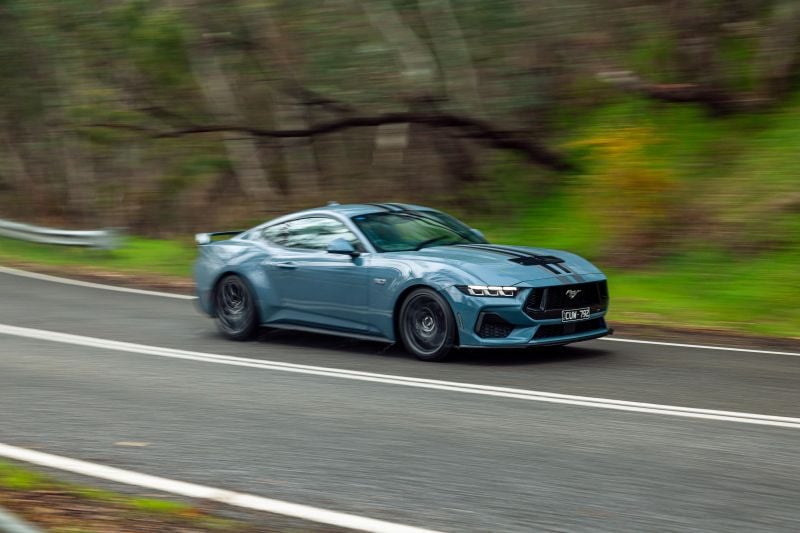
GT Fastback
Although the 10-speed automatic is a winner in traffic, it still just has too many damn gears.
It feels more decisive than before, picking a gear and sticking to it instead of slurring between three similar ratios on medium throttle inputs, but it still gets between you and a linear, logical response from the engine too often.
You just don’t need 10 gears in a car with as much torque as the Mustang, and there’s still a tendency for the gearbox to try every single gear, just for a moment, on its way to the right one.
That’s not an issue in the manual. Where the Dark Horse gets a Tremec six-speed manual, the GT has a Getrag unit. It’s still a six-speeder, and it’s still pretty firm and satisfying to work, but it’s just a little bit… soggy compared to the Dark Horse.
-
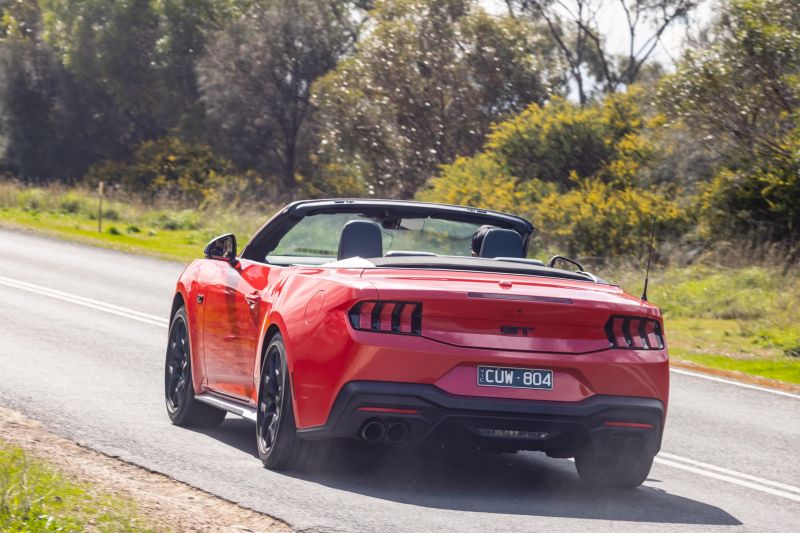
GT Convertible
Ride quality is still good enough that you could happily daily the Mustang. There’s enough of a soft edge to the way it deals with big bumps in the city, and at higher speeds it settles down nicely. Ford proudly claims the S650 is the most track-ready Mustang ever, but it also remains a very comfortable way to eat up long distances.
The MagneRide suspension is an option worth having. Without it, the EcoBoost we drove was a bit too springy on what should have been smooth roads, where the ability to dial things back into Comfort or ramp it up into Track makes for a more versatile muscle car.
All that track-readiness makes it a better way to pick apart a road as well, but there’s no getting away from the Mustang’s size and weight on narrow backroads.
The steering is quicker and lighter here than before, which makes it easier to throw into corners without taking your hands off the wheel, and traction from the front end is impressive given this is a big muscle car.
-

Dark Horse
There’s just always a layer of something holding you back from truly trusting the car and pushing at ten-tenths. It’s more fun to dial things back slightly and revel in the V8 thunder, which is kind of the point here.
With more space to play with on track, you can dig a bit deeper into what this pony can do at full speed. Even without the Dark Horse’s boosted track credentials, the GT is impressive around the The Bend in South Australia.
It rips down the back straight, and the brakes never faded on a warm day with Australia’s motoring media pushing the limits.
With auto rev-matching on hand to smooth out the rough edges it’s easy to snap from fifth to fourth, third, and second gear for the first corner.
There’s a lovely rear-wheel drive balance to the ‘Stang under power, and for such a big, heavy beast it doesn’t want to fall over itself or wallow around.
The Dark Horse is even better though. From the second you slot its six-speed manual transmission into first gear it’s more purposeful, and the impact of its shorter final drive ratio is immediately noticeable as you accelerate through the lower gears.
Where the GT feels quite long legged, the Dark Horse catches you unaware with the way it rips through the top end of its rev counter. If you’re not careful, it’s easy to snag the limiter.
If you want to spend serious time on track in your Mustang, the Dark Horse is the one to have… if you can find one.
What do you get?
The 2025 Ford Mustang range is now only offered in two trim levels, following all the Dark Horse examples selling out.
Mustang EcoBoost highlights:
- Brembo 6-piston front brake calipers, 4-piston rear calipers
- 19-inch alloy wheels
- Limited-slip differential
- Electronic park brake with Drift Brake
- Track Apps
- Active Valve Performance Exhaust with quad outlets
- Automatic LED headlights
- Automatic high-beam
- Puddle lights with Mustang logo
- 12.4-inch digital instrument cluster
- 13.2-inch touchscreen infotainment system
- Wireless Apple CarPlay and Android Auto
- Satellite navigation
- Wireless phone charger
- DAB+ digital radio
- FordPass Connect embedded modem
- 12-speaker B&O sound system
- Leather-wrapped steering wheel
- Tilt and telescopic steering adjustment
- Leather-wrapped shifter and park brake
- Metal pedals
- Dual-zone climate control
- Electrochromatic rear-view mirror
- Colour-adjustable ambient lighting
- Proximity entry with push-button start
- Illuminated sill plates
- One-touch up/down front windows
- Leather-accented upholstery
- Heated and cooled front seats
- 6-way power driver’s seat with power lumbar, manual backrest adjustment
- 6-way power passenger seat with manual backrest adjustment
- Split/fold rear seats
GT adds:
- V8 engine
- Auxiliary engine oil cooler
- Pirelli P-Zero tyres
Options
A number of option packages and individual parts are available for the 2025 Ford Mustang.
Bronze Appearance Pack (NEW): $1500 pre-LCT, $1950 including LCT
- Sinister Bronze pony (grille), GT (boot lid) and 5.0 (sides) badging
- Sinister Bronze painted 19-inch wheels
EcoBoost and GT Appearance Packs (N/A with MagneRide, Recaro seats): $1500 excl. LCT, $1950 inc. LCT (GT only)
- Black with grey over the top stripes
- Unique rear spoiler
MagneRide suspension and red Brembo brake calipers – $2950 excl. LCT, $3835 inc. LCT
Recaro sports seats (six-way power adjustable, non-heated or ventilated) – $2950 excl. LCT, $3835 inc. LCT
Is the Ford Mustang safe?
The 2025 Ford Mustang has yet to be tested by ANCAP or Euro NCAP.
Standard safety equipment includes:
- Autonomous emergency braking with pedestrian and cyclist detection
- Adaptive cruise control (includes stop/go and lane centring on auto models)
- Blind-spot assist
- Lane keep assist
- Rear cross-traffic assist
- Evasive steer assist
- Post-collision braking
- Deployable bonnet
- Reversing camera
- Rear parking sensors
- Front, front-side and passenger knee airbags
- Curtain airbags (coupe)
- Head-side airbags (convertible)
How much does the Ford Mustang cost to run?
The 2025 Ford Mustang is backed by a five-year, unlimited-kilometre warranty.
| Running costs | Ford Mustang |
|---|---|
| Warranty | 5 years, unlimited kilometres |
| Roadside assistance | Up to 7 years (service activated) |
| Service intervals | 12 months or 15,000 kilometres |
| Capped-price servicing | 4 years |
| Total capped-price service cost | $1516 |
CarExpert’s Take on the Ford Mustang
Ford has evolved the Mustang just enough to keep it relevant, without undermining what’s so damn special about it.
It still turns heads like nothing else for the price, and even after a price rise between generations it still represents great value.
The dollar-to-displacement ratio here, let alone the dollar-to-smile ratio, is off the charts when you consider what else is out there.
Based on our highway stint in the EcoBoost, it’s an improved take on a formula very few Australians bothered with last time around.
It’s punchy and relatively affordable alongside the V8, but it still doesn’t come close to matching the GT sitting atop the range for character.
With better technology inside, sharper looks outside, and an even better engine than before, the Mustang GT has evolved… but it’s still a dinosaur in the best way possible.
The only issue is how good the Dark Horse is. If you’re serious about taking your Mustang to the track, the changes Ford has made really do elevate the experience over the GT.
Even if you don’t have red-and-white kerb stones on your driveway, the more satisfying Tremec six-speed manual would make for a more enjoyable daily drive.
Come on Ford, give us more in right-hand drive.
Interested in buying a Ford Mustang? Get in touch with one of CarExpert’s trusted dealers here
Click the images for the full gallery
MORE: Everything Ford Mustang


